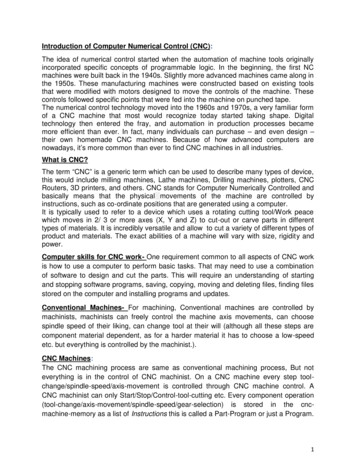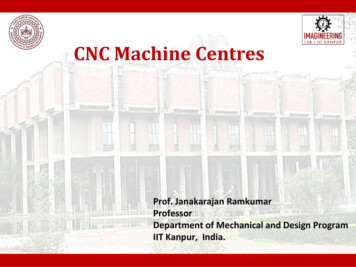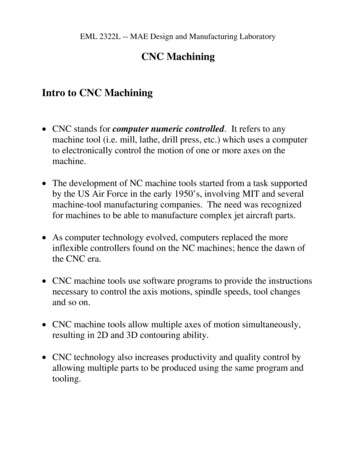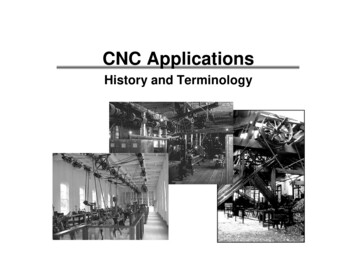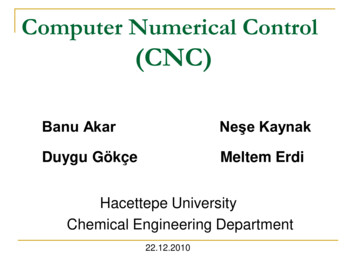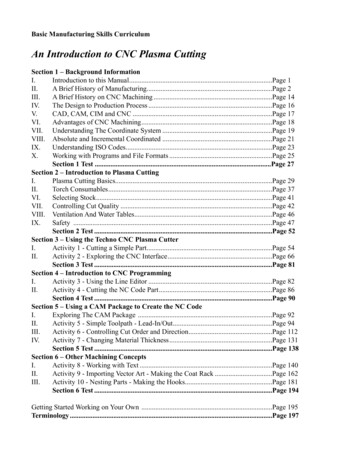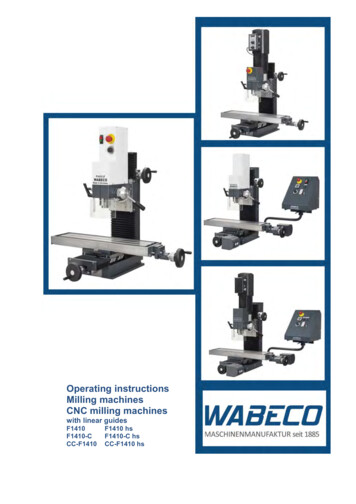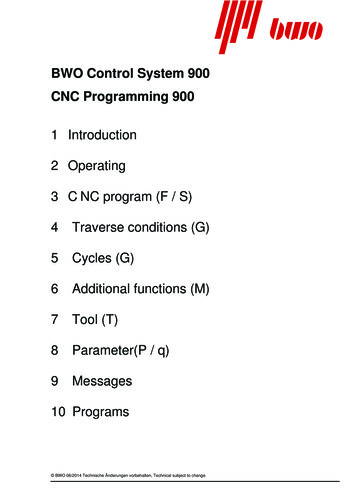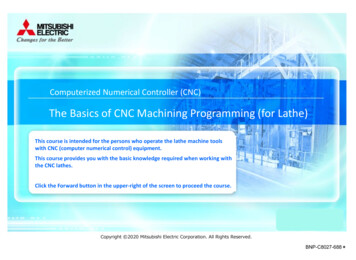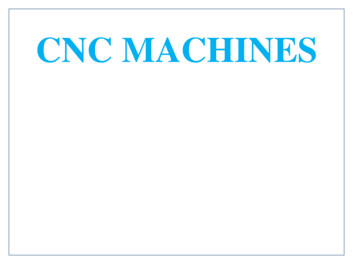
Transcription
What is a CNC Machine?CNC : Computerised Numerical Control(Computer Numerical Control) Numerical control is a programmable automation inwhich process is controlled by Numbers, Letters, andsymbols. CNC Machining is a process used in the manufacturingsector that involves the use of computers to controlmachine tools like lathes, mills and grinders.1
Why is CNC Machining necessary? To manufacture complex curved geometries in 2D or 3D wasextremely expensive by mechanical means (which usually wouldrequire complex jigs to control the cutter motions) Machining components with high Repeatability and Precision Unmanned machining operations To improve production planning and to increase productivity To survive in global market CNC machines are must to achieveclose tolerances.2
Ball screw / ball bearing screw / recirculating ballscrew Mechanism It consists of a screw spindle, anut, balls and integrated ball returnmechanism a shown in Figure . The flanged nut is attached to themoving part of CNC machine tool.As the screw rotates, the nuttranslates the moving part alongthe guide ways.Ballscrew configuration However, since the groove in the ball screw is helical, its steelballs roll along the helical groove, and, then, they may go out ofthe ball nut unless they are arrested at a certain spot.3
Thus, it is necessary to change their path after they have reacheda certain spot by guiding them, one after another, back to their“starting point” (formation of a recirculation path). Therecirculation parts play that role. When the screw shaft is rotating, as shown in Figure, a steel ballat point (A) travels 3 turns of screw groove, rolling along thegrooves of the screw shaft and the ball nut, and eventuallyreaches point (B). Then, the ball is forced to change its pathway at the tip of thetube, passing back through the tube, until it finally returns topoint (A). Whenever the nut strokes on the screw shaft, the balls repeat thesame recirculation inside the return tube.4
When debris or foreign matter enter the inside of the nut, itcould affect smoothness in operation or cause prematurewearing, either of which could adversely affect the ball screw'sfunctions. To prevent such things from occurring, seals are provided tokeep contaminants out. There are various types of seals viz.plastic seal or brush type of seal used in ball-screw drives.5
Characteristics of ball screws High mechanical efficiencyIn ball screws, about 90% or more of the force used to rotatethe screw shaft can be converted to the force to move the ball nut.Since friction loss is extremely low, the amount of forceused to rotate the screw shaft is as low as one third of that neededfor the acme thread lead screw. Low in wearBecause of rolling contact, wear is less than that of slidingcontact. Thus, the accuracy is high.Ball screws move smoothly enough under very slow speed.They run smoothly even under a load.6
Thread FormThe thread form used in these screws can either be gothicarc type (fig.a) or circular arc type (fig.b). The friction in this kindof arrangement is of rolling type. This reduces its wear ascomparison with conventional sliding friction screws drives.Thread forms (a) Gothic arc (b) Circular arcRecirculating ball screws are of two types. In one arrangement theballs are returned using an external tube. In the other arrangementthe balls are returned to the start of the thread in the nut through a7channel inside the nut.
PreloadingIn order to obtain bidirectional motion of the carriagewithout any positional error, the backlash between the nut andscrew should be minimum.Zero backlash can be obtained by fitting two nuts with preloading(tension or compression) or by applying a load which exceeds themaximum operating load.Figure shows double nutpreloading system. A shim plate(spacer) is inserted between twonuts for preloading. Preload is tocreateelasticdeformations(deflections) in steel balls andball grooves in the nut and thescrew shaft in advance byproviding an axial load.Double nut preloading system8
As a result the balls in one of the nuts contact the one side of thethread and balls in the other nut contact the opposite side.Effects of preload Zero backlash: It eliminates axial play between a screw shaftand a ball nut. It minimizes elastic deformation caused by external force, thusthe rigidity enhances. In case mounting errors, misalignment between the screw shaftand the nut may occur this further generates distortion forces. This could lead to the problems such as,Shortened service lifeAdverse effect on smooth operationReduced positioning accuracyGeneration of noise or vibrationBreakage of screw shaft9
Advantages of ball screws Highly efficient and reliable. Less starting torque. Lower co efficient of friction compared to sliding type screwsand run at cooler temperatures Power transmission efficiency is very high and is of the order of95 %. Could be easily preloaded to eliminate backlash. The friction force is virtually independent of the travel velocityand the friction at rest is very small; consequently, the stick-slipphenomenon is practically absent, ensuring uniformity ofmotion. Has longer thread life hence need to be replaced less frequently. Ball screws are well -suited to high through output, high speedapplications or those with continuous or long cycle times. Smooth movement over full range of travel.10
Disadvantages of ball screws Tend to vibrate. Require periodic overhauling to maintain their efficiency. Inclusion of dirt or foreign particles reduces the life of thescrews. Not as stiff as other power screws, thus deflection and criticalspeed can cause difficulties. They are not self-locking screws hence cannot be used inholding devices such as vices. Require high levels of lubrication.11
Applications of ball screws Ball screws are employed in cutting machines, such asmachining center and NC lathe where accurate positioning ofthe table is desired Used in the equipment's such as lithographic equipment orinspection apparatus where precise positioning is vital High precision ball screws are used in steppers forsemiconductor manufacturing industries for precision assemblyof micro parts. Used in robotics application where precision positioning isneeded. Used in medical examination equipment's since they are highlyaccurate and provide smooth motion.12
DIFFERENCES BETWEEN CNC MACHINES TOOLS ANDCONVENTIONAL MACHINE TOOLS Constructional details: Basically conventional machine have 2 axes, knownas X & Y axis. There is also a Z axis long which only the bedmoves vertically. The spindle along with the tool does not move as it isfixed with the machine body .But in case of CNC machine, there are minimum 3 axeswith Spindle moving parallel to Z axis.13
CNC machines have more rigid construction whencompared to the conventional machine. The slide ways, guide and spindles of the CNCmachine all look over proportioned when compared tothe conventional machine.The structure of the CNC machine is therefore designedto cope with the torsional forces and heavy duty cuttingimposed on these machines.14
Recirculating ball lead screws and anti friction slidewaysCONVENTIONAL The slide ways on a conventional machine operateunder the conditions of sliding friction. The lead screws are usually of the Acme threadform, which are inefficient due to the highfrictional resistance between the flanks of the screwand the nut. There is also backlash, because of theclearance between the screw and the nut.15
CNC Rolling friction can be used instead of sliding friction,where re-circulating roller bearings are positionedunder the slide ways. A recirculating ball lead screw, where both the leadscrew and the nut have a precision ground radiusedshaped thread. The space or track between the leadscrew and nut is filled with an endless stream or ballbearings.The advantages are longer life, less frictional resistance,lower torque required, more precise positioning of slides,where backlash is almost completely eliminated.16
Use of Stepping Motors in Slide MovementThe slides and spindle of the CNC machine are driven bystepper motors.STEPPER MOTOR – A digital signal is sent from thecontroller to the motor in the form of pulses, which willcause the motor to rotate through a specified angle, whichcauses the slide to move by the required distance.17
Example:If five digital pulses are sent to the stepper motor then it willrotate by five steps, which is converted to linear movement bythe lead screw. The speed by which the pulses are sent to thestepper motor will determine the velocity of the slidemovement. As the distance moved by the slide and the feedcan be accurately controlled by the CNC control system, thereis no need for positional or velocity feedback18
MAJOR COMPONENTS RELATED TO CNC MACHINETOOLSAny CNC machine tool essentially consists of the following parts: Part program: A series of coded instructions required to produce a part. Controls the movement of the machine tool and on/offcontrol of auxiliary functions such as spindle rotationand coolant. The coded instructions are composed of letters, numbersand symbols.19
Program input device The program input device is the means for partprogram to be entered into the CNC control. Three commonly used program input devices arepunch tape reader, magnetic tape reader, andcomputer via RS-232-C communication.20
Machine Control UnitThe machine control unit (MCU) is the heart of a CNCsystem. It is used to perform the following functions: To read the coded instructions. To decode the coded instructions. To implement interpolations (linear, circular, andhelical) to generate axis motion commands. To feed the axis motion commands to the amplifiercircuits for driving the axis mechanisms. To receive the feedback signals of position and speedfor each drive axis. To implement auxiliary control functions such ascoolant or spindle on/off and tool change.21
Machine Tool CNC controls are used to control various types ofmachine tools. Regardless of which type of machine tool iscontrolled, it always has a slide table and a spindleto control position and speed. The machine table is controlled in the X and Yaxes, while the spindle runs along the Z axis.22
Feed Back System The feedback system is also referred to as themeasuring system. It uses position and speed transducers to continuouslymonitor the position at which the cutting tool is locatedat any particular instant. The MCU uses the difference between reference signalsand feedback signals to generate the control signals forcorrecting position and speed errors.23
Drive System Drives are used to provide controlled motion toCNC elements A drive system consists of amplifier circuits, drivemotors, and ball lead-screws. The MCU feeds the control signals (position andspeed) of each axis to the amplifier circuits. The control signals are augmented to actuate drivemotors which in turn rotate the ball lead-screws toposition the machine table.24
POWER DRIVES In machine tools, power is generally required for driving the mainspindle, saddles and carriages and to some auxiliary units. The motors used for CNC system are of two kinds Electrical - AC , DC or Stepper motors Fluid - Hydraulic or Pneumatic In CNC, usually stepper and servo electrical drives are used They exhibit favourable torque-speed characteristics and arerelatively inexpensive.25
STEPPER MOTORA stepper motor is a pulse-driven motor thatchanges the angular position of the rotor in steps.Due to this nature of a stepper motor, it iswidely used in low cost, open loop position controlsystems.Types of stepper motors:o Permanent MagnetEmploy permanent magnetLow speed, relatively high torqueo Variable ReluctanceDoes not have permanent magnetLow torque26
Permanent magnet (PM) stepper motor Rotor is a permanent magnet. PM motor rotor has no teeth and is designed to be magnetized ata right angle to its axis. Figure shows a simple, 90⁰ PMmotor with four phases (A-D). Applying current to each phasein sequence will cause the rotorto rotate by adjusting to thechanging magnetic fields. Although it operates at fairly lowspeed, the PM motor has arelativelyhightorquecharacteristic.Permanent magnet stepper These are low cost motors with typical step angle rangingbetween 7.5⁰ to 15⁰27
Variable Reluctance Motor The cylindrical rotor is made of soft steel and has four poles It has four rotor teeth, 90⁰ apart and six stator poles, 60⁰ apart. Electromagnetic field is produced by activating the stator coilsin sequence. It attracts the metal rotor. Whenthe windings are energized in areoccurring sequence of 2, 3, 1,and so on, the motor will rotatein a 30⁰ step angle. In the non-energized condition,there is no magnetic flux in theair gap, as the stator is anelectromagnet and the rotor is apiece of soft iron; hence, there isno detent torque.Fig. Variable reluctance stepper motor28
Hybrid stepper motor Hybrid stepping motors combine apermanent magnet and a rotor withmetal teeth to provide features ofthe variable reluctance andpermanent magnet motors together. The number of rotor pole pairs isequal to the number of teeth on oneof the rotor's parts. The hybridmotor stator has teeth creatingmore poles than the main poleswindingsHybrid stepper29
Rotation of a hybrid stepping motor is produced in thesimilar fashion as a permanent magnet stepping motor,by energizing individual windings in a positive ornegative direction. When a winding is energized, north and south poles arecreated, depending on the polarity of the currentflowing. These generated poles attract the permanent poles of therotor and also the finer metal teeth present on rotor.30
The rotor moves one step to align the offsetmagnetized rotor teeth to the correspondingenergized windings. Hybrid motors are more expensive than motors withpermanent magnets, but they use smaller steps, havegreater torque and maximum speed. Step angle of a stepper motor is given by,31
Advantages of stepper motors Low cost Ruggedness Simplicity of construction Low maintenance Less likely to stall or slip Will work in any environment Excellent start-stop and reversing responsesDisadvantages of stepper motors Low torque capacity compared to DC motors Limited speed During overloading, the synchronization will be broken.Vibration and noise occur when running at high speed.32
SERVO MOTORS Servomotors are special electromechanical devices that produceprecise degrees of rotation. A servo motor is a DC or AC or brushless DC motor combinedwith a position sensing device. Servomotors are also called control motors as they are involved incontrolling a mechanical system. The servomotors are used in a closed-loop servo system as shownin Figure A reference input is sent to the servo amplifier, whichcontrols the speed of the servomotor.Servo system block diagram33
A feedback device is mounted on the machine, whichis either an encoder or resolver. This device changes mechanical motion into electricalsignals and is used as a feedback. This feedback is sent to the error detector , whichcompares the actual operation with that of thereference input. If there is an error, that error is fed directly to theamplifier, which will be used to make necessarycorrections in control action.34
In many servo systems, both velocity and position aremonitored. Servomotors provide accurate speed, torque, and haveability of direction control.DC servomotorsDC operated servomotors are usually respond toerror signal abruptly and accelerate the load quickly. ADC servo motor is actually an assembly of four separatecomponents, namely:o DC motoro gear assemblyo position-sensing device35o control circuit
AC servo motor Magnetic force is generated by a permanent magnet andcurrent which further produce the torque. It has no brushes so there is little noise/vibration. Thismotor provides high precision control with the help ofhigh resolution encoder. The stator is composed of a core and a winding. Therotor part comprises of shaft, rotor core and a permanentmagnet. Digital encoder can be of optical or magnetic type. Itgives digital signals, which are in proportion of rotationof the shaft.36
Advantages of servo motors Provides high intermittent torque, high torque to inertiaratio, and high speeds Work well for velocity control Available in all sizes Quiet in operation Smoother rotation at lower speedsDisadvantages of servo motors More expensive than stepper motors Require tuning of control loop parameters Not suitable for hazardous environments or in vacuum Excessive current can result in partial demagnetizationof DC type servo motor37
LINEAR MOTION DRIVES Linear motion drives are mechanical transmission systemswhich are used to convert rotary motion into linear motion. The conventional thread forms like vee or square are notsuitable in CNC because of their high wear and less efficiency. Therefore CNC machines generally employ ball screw fordriving their workpiece carriages. These drives provide backlash free operation with low frictionwear characteristics. These are efficient and accurate in comparison with that of nutand-screw drives. Most widely used linear motion drives areball screws.38
PART PROGRAMMING39
INTRODUCTIONA group of commands given to the CNC for operating themachine is called the program.It consists of: Information about part geometry Motion statements to move the cutting tool Cutting speed Feed Auxiliary functions such as coolant on and off, spindledirection40
CNC program structureThere are four basic terms used in CNC programmingCharacter - Word - Block - Program Character is the smallest unit of CNC program. It can have Digit/ Letter / Symbol. Word is a combination of alpha-numerical characters. Thiscreates a single instruction to the CNC machine. Each wordbegins with a capital letter, followed by a numeral. These areused to represent axes positions, federate, speed, preparatorycommands, and miscellaneous functions. A program block may contain multiple words, sequenced in alogical order of processing. The program comprises of multiple lines of instructions, „blocks‟which will be executed by the machine control unit (MCU).41
FIXED ZERO v/s FLOATING ZEROFixed zero: Origin is always located at some position on M/Ctable (usually at south west corner/Lower left-hand)of the tables & all tool location are defined W.R.T.this zeroFloating Zero: Very common with CNC M/C used now a days. Operator sets zero point at any convenient positionon M/C table. The Coordinate system is knows as work coordinatesystem (WCS)42
Modal and Non modal commands Commands issued in the NC program may stay ineffect indefinitely (until they explicitly cancelled orchanged by some other command), or they may beeffective for only the one time that they are issued. The former are referred as Modal commands.Examples include feed rate selection and coolantselection. Commands that are effective only when issued andwhose effects are lost for subsequent commands arereferred to as non-modal commands. A dwell command, which instructs the tool to remain ina given configuration for a given amount of time, is anexample of a non-modal command.43
Structure of an NC part program An NC part program is made up of a series of commands thatare input into the MCU in a serial manner. The MCU interprets these commands and generates thenecessary signals to each of the drive units of the machine toaccomplish the required action. The NC program is required to have a particular structure thatthe controller can understand and it must follow a specificsyntax. Commands are inputs into the controller in units called blocks orstatements. Each block is made up of one or more machine commands.44
In general, several commands are grouped together toaccomplish a specific machining operation, hence the use of ablock of information for each operation. Each command gives a specific element of control data, such asdimension or a feed rate. Each command within a block is alsocalled a word. The way in which words are arranged within the block is calledblock format. Three different block formats are commonly used, (Fixedsequential format, Tab sequential format and Word addressformat)45
Word Sequential Format : Used on virtually all modern controllers.N50 G00 X50 Y25 Z0 F0N60 G01 Z-1 F50 M08N70 Z0 M09 With this type of format, each type of word is assigned as addressthat is identified by a letter code within the part program. Thus the letter code specifies the type of word that follows and thenits associated numeric data is given. For example, the code T represents a tool number. Thus a word ofthe form T01 would represent tool number 1. Theoretically, with this approach, the words in a given block can beentered in any sequence and the controller should be able tointerpret them correctly.46
With the word address format only the needed words for agiven operation have to be included within the block. The command to which the particular numeric data appliesis identified by the preceding address code. Word format has the advantage of having more than oneparticular command in one block something that would beimpossible in the other two formats.47
COMMONLY USED WORD ADDRESSES N-CODE: Sequence number, used to identify each block with inan NC program and provides a means by which NC commandsmay be rapidly located. It is program line number. It is a goodpractice to increment each block number by 5 to 10 to allowadditional blocks to be inserted if future changes are required. G-CODE: Preparatory Word, used as a communication device toprepare the MCU. The G-code indicates that a given controlfunction such as G01, linear interpolation, is to be requested. X, Y & Z-CODES: Coordinates. These give the coordinatepositions of the tool.48
F-CODE: Feed rate. The F code specifies the feed in themachining operation. S-CODE: Spindle speed. The S code specifies the cutting speedof the machining process. T-CODE: Tool selection. The T code specifies which tool is tobe used in a specific operation. M-CODE: Miscellaneous function. The M code is used todesignate a particular mode of operation for an NC machinetool. I, J & K-CODES: They specify the centre of arc coordinatesfrom starting.49
Sequence and format of words:N3 G2 X 1.4 Y 1.4 Z 1.4 I2.0 J2.0 K2.0 F5 S4 T4 M2sequence nodestination coordinatespreparatory functionfeed ratedist to center of circletoolspindle speedOther function
51
List of M codesM codes vary from machine to machine depending on thefunctions available on it. They are decided by the manufacturer ofthe machine. The M codes listed below are the common ones.52
G00 Rapid traverseWhen the tool being positioned at a point preparatory to a cuttingmotion, to save time it is moved along a straight line at Rapidtraverse, at a fixed traverse rate which is pre-programmed into themachine's control system.Typical rapid traverse rates are 10 to 25 m /min., but can be as highas 80 m/min.Syntax: N010 [G90/G91] G00 X10 Y10 Z5
G01 Linear interpolation (feed traverse)The tool moves along a straight line in one or twoaxis simultaneously at a programmed linear speed, thefeed rate.Syntax: N010[G90/G91] G01 X10 Y10 Z5 F25
G02/G03 Circular interpolationFormatN G02/03 X Y Z I J K F using the arc centerorN G02/03 X Y Z R F using the arc radiusArc centerThe arc center is specified by addresses I, J and K. I, J and K are the X, Y and Zco-ordinates of the arc center with reference to the arc start point.G02 moves along a CW arcG03 moves along a CCW arc
G90 ABSOLUTE POSITION COMMAND When using a G90 absolute position command, each dimension or move isreferenced from a fixed point, known as ABSOLUTE ZERO (part zero). Absolute zero is usually set at the corner edge of a part, or at the center of asquare or round part, or an existing bore. ABSOLUTE ZERO is where thedimensions of a part program are defined from. Absolute dimensions are referenced from a known point on the part, andcan be any point the operator chooses, such as the upper-left corner, centerof a round part, or an existing bore.Syntax: N. G90 X. Y. Z. A. B. C.
G91 INCREMENTAL POSITION COMMAND This code is modal and changes the way axis motioncommands are interpreted. G91 makes all subsequentcommands incremental. Zero point shifts with the newposition.Syntax: N. G91 X. Y. Z. A. B. C.
G 17 G18 G19 : PLANE SELECTIONG 17 : XY plane selectionSyntax: N. G17G 18 : ZX plane selectionSyntax: N. G18G 19 : ZY plane selectionSyntax: N. G19Syntax: N020 G17 G75 F6.0 S300 T1001 M08
G 70 Inch data inputG 71 Metric data inputSyntax : N010 G70 G90 G94 G97 M04
Manual Part Programming Example5”2.5”p3p2p4p51”Tool size 0.25 inch,Feed rate 6 inch per minute,Cutting speed 300 rpm,Tool start position: 2.0, 2.0Programming in inches5”45 (4, 4)p1p0 (2, 2)Motion of tool:p0 p1 p2 p3 p4 p5 p1 p0
1. Set up the programming parameters5”2.5”p3p2p4p51”Programming in inches5”Use absolute coordinatesFeed in ipm45 N010 G70 G90 G94 G97 M04(4, 4)p1p0 (2, 2)Spindle speed in rpmSpindle CCW
2. Set up the machining conditions5”2.5”p3p2p4p51”Machine moves in XY-planeUse full-circle interpolation5”Feed rateSpindle speed45 N020 G17 G75 F6.0 S300 T1001 M08(4, 4)p1p0 (2, 2)Tool no.Flood coolant ON
3. Move tool from p0 to p1 in straight line5”2.5”p3p21”p4p5Linear interpolationtarget coordinatesN030 G01 X3.875 Y3.6985”45 (4, 4)p1p0 (2, 2)
4. Cut profile from p1 to p25”2.5”p3p2p4p51”Linear interpolation5”target coordinatesN040 G01 X3.875 Y9.12545 or(4, 4)p1N040 G01 Y9.125p0 (2, 2)X-coordinate does not change no need to program it
5. Cut profile from p2 to p35”2.5”p3p2p4p5Linear interpolationtarget coordinates1”N050 G01 X5.634 Y9.1255”y 9 0.125 9.125(6.5 - x)2 0.1252 (1 - 0.125)2x 5.63445 p3(x, y)(4, 4)p1(6.5, 9).125p0 (2, 2)1”
6. Cut along circle from p3 to p45”2.5”p3p2p4p51”circular interpolation, CCW motion5”target coordinates45 (4, 4)N060 G03 X7.366 Y9.125 I6.5 J9.0coordinates of center of circlep1p0 (2, 2)N060 G03 X7.366 Y9.125 I0.866 J-0.125
7. Cut from p4 to p55”2.5”p3p2p4p51”5”Linear interpolation45 (4, 4)p1p0 (2, 2)target coordinates (Y is unchanged)N070 G01 X9.302
8. Cut from p5 to p15”2.5”p3p2p4p51”5”Linear interpolationtarget coordinates (see step 3)45 N080 G01 X3.875 Y3.698(4, 4)p1p0 (2, 2)
9. Return to home position, stop program5”2.5”p3p2p4p51”Linear interpolationtarget coordinates (see step 3)5”N090 G01 X2.0 Y2.0 M3045 (4, 4)p1p0 (2, 2)end of dataN100 M00program stop
10. Complete RS-274 programN010 G70 G90 G94 G97 M04N020 G17 G75 F6.0 S300 T1001 M08N030 G01 X3.875 Y3.698N040 G01 X3.875 Y9.125N050 G01 X5.634 Y9.125N060 G03 X7.366 Y9.125 I0.866 J-0.125N070 G01 X9.302N080 G01 X3.875 Y3.698N090 G01 X2.0 Y2.0 M30
Simple G Code Example CNC Lathe
PART PROGRAMN5 M12N10 T0101N15 G0 X100 Z50N20 M3 S600N25 M8N30 G1 X50 Z0 F600N40 Y-30 F200N50 X80 Y-20 F150N60 G0 X100 Z50N70 T0100N80 M5N90 M9N100 M13N110 M30
Code ExplanationN5 Clamping workpieceN10 Changing No.1 tool and executing its offsetN15 Rapidly positioning to A pointN20 Starting the spindle with 600 r/minN25 Cooling ONN30 Approaching B point with 600mm/minN40 Cutting from B point to C pointN50 Cutting from C point to D pointN60 Rapidly retracting to A pointN70 Cancelling the tool offsetN80 Stopping the spindleN90 Cooling OFFN100 Releasing workpieceN110 End of program, spindle stopping and Cooling OFF
CNC MILLING EXAMPLE
N5 G90 G71N10 T1 M6N15 G92 X-100 Y86 Z95N20 G0 X0 Y0 S2500 M3N25 Z12.5N30 G1 Z-12.5 F150N35 X-20 Y30N40 G2 X10 Y100 R80N45 G1 X140 Y60N50 G2 X150 Y0 R50N55 G1 X0 Y0N60 G0 Z12.5N65 G91 G28 Z0 M5N70 G91 G28 X0 Y0N75 M30
CODE EXPLANATIONN5 absolute positioning, metric unitN10 tool change to T1N15 define work zero point at AN20 rapid traverse to A, spindle on (2500 RPM, CW)N25 rapid plunge to 12.5 mm above Z0N30 feed to Z-12.5, feed rate 150 MMPMN35 cut line AB to BN40 cut arc BC to CN45 cut line CD to DN50 cut arc DE to EN55 cut line EA to AN60 rapid retract to Z12.5N65 reference point return in Z direction, spindle offN70 reference point return in X and Y directionsN75 end of program
SAMPLE PROGRAM ON DRILLING
N1 T16 M06N2 G90 G54 G00 X0.5 Y-0.5N3 S1450 M03N4 G43 H16 Z1. M08N5 G81 G99 Z-0.375 R0.1 F9.N6 X1.5N7 Y-1.5N8 X0.5N9 G80 G00 Z1. M09N10 G53 G49 Z0. M05N11 M30
CODE EXPLANATIONN1- Tool change (M06) to tool no.16N2- Tool rapidly moves (G00) to first drilling position X0.5 Y-0.5 while taking intoaccount Zero-offset-no. 1 (G54)N3- Drill starts rotating clockwise (M03) with 1450 rpm (S1450).N4- Drill takes depth Z1. taking into account tool length compensation (G43 H16),coolant is turned on (M08).N5- Drilling cycle (G81) parameters, drill depth (Z) and cutting feed (F) are given,with this command first drill is made at current position (X0.5 Y-0.5).N6- As drilling cycle continues it’s work with every axis movement so next drill isdone at X1.5N7- Third drilling hole at Y-1.5
N8- Fourth drill at X0.5N9- Drilling cycle is cancelled (G80), Coolant is turned off (M09).N10- Taking Machine-coordinate-system (G53) into account the drill is takento Z0 position. Tool length compensation is cancelled (G49), cutter rotationis stopped (M05).N11- CNC part-program is ended.
Typical PROGRAMMING - TURNING OPERATIONSWrite a part program for turning operations being carried out on aCNC turning center. Let us take an exercise:Figure shows the final profile to be generated on a bar stock byusing a CNC turning center. After studying the required partgeometry and features, the main program can be wr
The structure of the CNC machine is therefore designed to cope with the torsional forces and heavy duty cutting imposed on these machines. CNC machines have more rigid construction when compared to the conventional machine. The slide ways, guide and spindles of the CNC machine all look over proportioned when compared to the conventional .File Size: 1MBPage Count: 82
